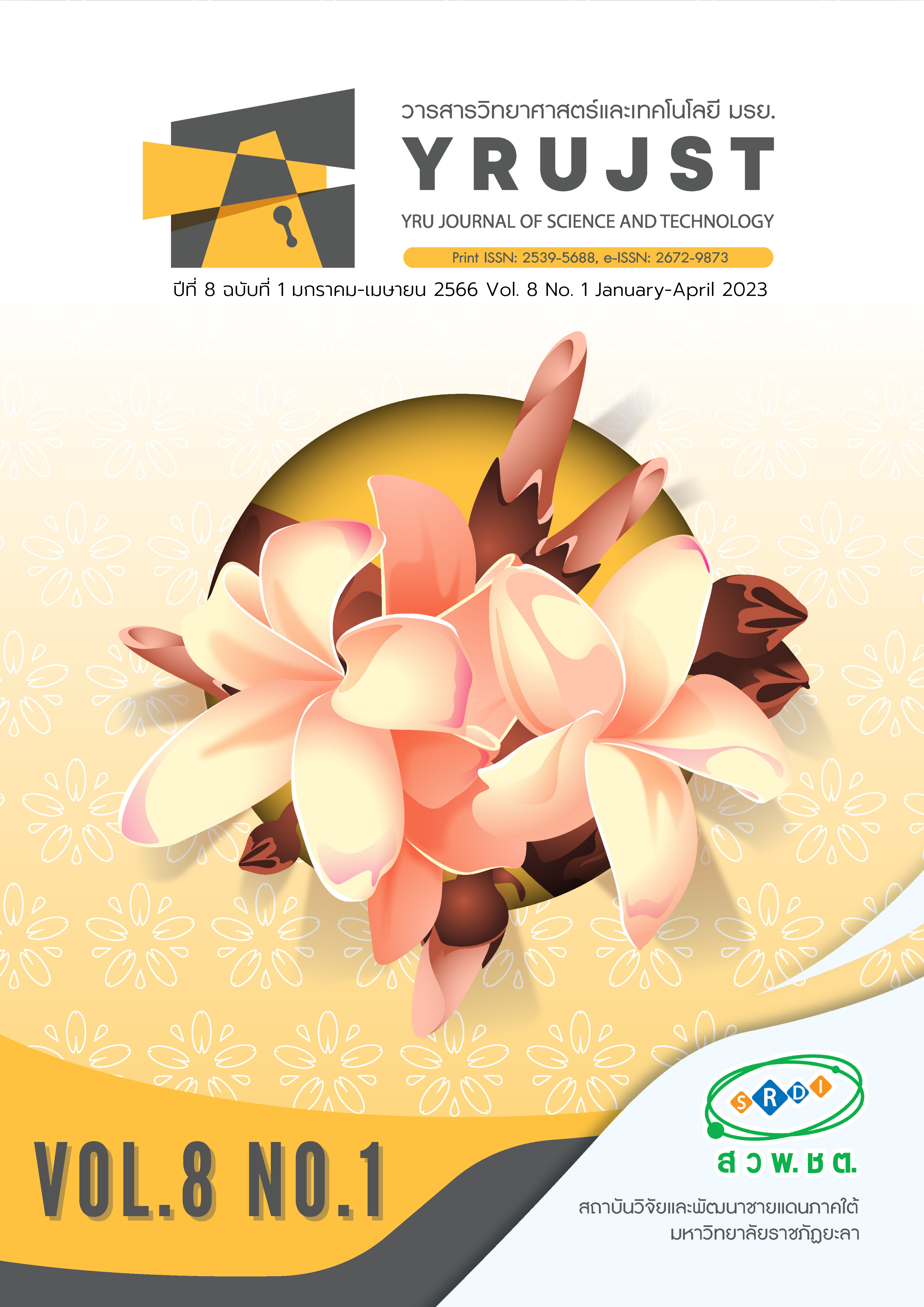High-Performance Liquid Chromatography with Diode-Array Detector for Screening of Carbamate Insecticide Residues in Vegetable Samples Using QuEChERS Extraction
Main Article Content
Abstract
Aldicarb, carbofuran, methomyl and oxamyl are carbamates insecticides. They are highly toxic and inhibit the enzyme activity of acetylcholinesterase (AChE); therefore, high residual carbamate contents in vegetables may affect consumer health. This research aimed to determine for screening of 4 carbamate residues by high-performance liquid chromatography with a diode array detector using QuEChERS extraction and clean-up purification with dispersive solid phase extraction. The chromatographic separation was performed on the C18 column using gradient elution by water and methanol at a 1 mL/min flow rate. The column temperature was controlled at 40 °C. The injection volume was 10 µL. The good linearity over a range of the concentration 0.04-2.50 mg/kg (r2>0.995). The limit of quantification was 0.05-0.07 mg/kg. Accuracy was expressed as a percentage recovery in the range of 79.25-118.57, and the precision was described as a HORRAT value of no more than 2. The method was applied for screening six vegetables, including kale, cabbage, Chinese cabbage, bog choy, green onion and chili which investigated each type for five samples, and the total conclusion was 30 samples. The scanning showed that the pesticide residues in vegetables exceeded pesticide residues, and oxamyl content was 0.15 and 0.17-0.30 mg/kg in green onion and chili, respectively. A methomyl content of 0.17 mg/kg was found in kale and green onion, and carbofuran was 0.40-0.70 mg/kg in chili.
Article Details

This work is licensed under a Creative Commons Attribution-NonCommercial-NoDerivatives 4.0 International License.
บทความ ข้อมูล เนื้อหา รูปภาพ ฯลฯ ที่ได้รับการเผยแพร่ในวารสารวิทยาศาสตร์และเทคโนโลยี มรย. นี้ ถือเป็นลิขสิทธิ์ของวารสารวิทยาศาสตร์และเทคโนโลยี มรย. หากบุคคลหรือหน่วยงานใดต้องการนำทั้งหมดหรือส่วนหนึ่งส่วนใดไปเผยแพร่ต่อหรือกระทำการใดๆ จะต้องได้รับอนุญาตเป็นลายลักษณ์อักษรจากวารสารวิทยาศาสตร์และเทคโนโลยี มรย. ก่อนเท่านั้น
References
Akcaboot, P., Chukiatwatana, L. & Tongcham, C. (2020). Method validation of organophosphorus, organochlorine and pyrethroid in vegetable Oil. The 58th Kasetsart University Annual Conference, February 5-7, 2020 Bangkok: Kasetsart University. (in Thai)
Bongphrom, S. & Pabchanda, S. (2012). Determination of carbamate insecticides in chili using chromatographic and colorimetric techniques. Journal of Science and Technology, Ubon Ratchathani University, 14(3), 45–54. (in Thai)
Bose, A. (2014). HPLC calibration process parameters in terms of system suitability test. Austin Chromatography,1(2), 1-4.
Codex alimentarius FAO-WHO. (2022). Pesticides [Online]. Retrieved November 8, 2022, from: https://www.fao.org/fao-who-codexalimentarius/codex-texts/dbs/pestres/pesticides/en/.
Hinhumpatch, P. & Wattanachaiyingcharoen, W. (2021). Evaluation of carbamate pesticide residues in melons. Thai Science and Technology Journal, 29(1), 62–72. (in Thai)
Kemmerich, M., Bernardi, G., Prestes, O. D., Adaime, M. B., & Zanella, R. (2018). Comprehensive method validation for the determination of 170 pesticide residues in pear employing modified QuEChERS without clean-up and ultra-high performance liquid chromatography coupled to tandem mass spectrometry. Food Analytical Methods, 11(2), 556–577.
Kongphonprom, K. & Burakham, R. (2016). Determination of carbamate insecticides in water, fruit, and vegetables by ultrasound-assisted dispersive liquid–liquid microextraction and high-performance liquid chromatography. Analytical Letters, 49(6), 753–767.
Krinsunthon, N., Khamthong, T. & Mapradit, P. (2014). QuEChERS sample preparation for determination of steroids adulterated in herbal pills by high performance liquid chromatography. Thai Food and Drug Journal, 21(1), 59–66. (in Thai)
Ma, L., Zhao, L., Wang, J., Pan, C., Liu, C., Wang, Y., et al. (2020). Determination of 12 carbamate insecticides in typical vegetables and fruits by rapid multi-plug filtration cleanup and ultra-performance liquid chromatography/tandem mass spectrometry detection. Journal of Chromatographic Science, 58(2), 109–116.
Ningnoi, T. (2006). A Practical guide for single laboratory. method validation of chemical method. Nonthaburi: Department of medical sciences, ministry of public health. (in Thai)
Nur ’Aqilah, N. M., Erna, K. H., Vonnie, J. M., Rovina, K., Nur ’Aqilah, N. M., Erna, K. H., Vonnie, J. M. & Rovina, K. (2022). Extraction and identification techniques for quantification of carbamate pesticides in fruits and vegetables. in pesticides—updates on toxicity, efficacy and risk assessment [Online]. Retrieved November 6, 2022, from: https://www.intechopen.com/chapters/80551.
Pesticide residues in food. (2017, 18 September). Royal Gazette. 134(Special Part 228). 8-10. (in Thai)
Polyiem, W., Naksen, W. & Prapamontol, T. (2018). Gas chromatographic- flame photometric detection of organophosphate pesticide residues and its application in real vegetable and fruit samples from Chiang Mai city, Thailand. Chiang Mai Journal of Science., 45(4), 1933–1943.
Sparks, T. C., Crossthwaite, A. J., Nauen, R., Banba, S., Cordova, D., Earley, F., et al. (2020). Insecticides, biologics and nematicides: Updates to IRAC’s mode of action classification-a tool for resistance management. Pesticide Biochemistry and Physiology, 167, 104587.
Srikote, R. & Wittayanan, W. (2018). Development of an analytical method for pesticide residues in fruit or vegetable juices. Bulletin of the Department of Medical Sciences, 60(3), 108-122. (in Thai)
Zhang, Y. (2019). Analysis of organophosphorus and organochlorine pesticides in fruit and vegetables using an Agilent 8890 GC with four detectors [Online]. Retrieved November 8, 2022, from: https://www.agilent.com/cs/library/applications/application-organophosphorus-organochlorine-pesticides-5994-1215en-agilent.pdf
Zhou, Y., Guan, J., Gao, W., Lv, S. & Ge, M. (2018). Quantification and confirmation of fifteen carbamate pesticide residues by multiple reaction monitoring and enhanced product ion scan modes via LC-MS/MS QTRAP system. Molecules, 23(10), 2496.


